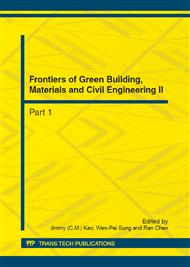p.1397
p.1401
p.1405
p.1414
p.1418
p.1424
p.1429
p.1436
p.1440
The Square Steel Tube Columns Filled with Steel-Reinforced Concrete Bias Supporting Capacity Unified Solution
Abstract:
The eccentric ultimate load calculation formula of square steel tube columns filled with steel-reinforced concrete was derived based on the Unified Strength Theory in this paper. The influence of intermediate principal stress and the restriction effect and the decrease of longitudinal stress were considered in the formula. Based on the axial compression load and the effect of consider the eccentricity ratio and slenderness ratio on the hearing capacity was considered, by introducing the reduction factor of concrete strength and the equivalent restriction reduction factor, the confinement of square steel tube towards concrete was equivalent to the confinement of circular steel tube towards it, based on unified strength theory solutions of thick tube, the calculation formula of eccentric compression bearing capacity of square steel tube columns filled with steel-reinforced concrete was deduced and analysed the influence complication. The results indicate unified strength theory has the good applicability and the solution has an important practical value for engineering application.
Info:
Periodical:
Pages:
1418-1423
Citation:
Online since:
August 2012
Authors:
Price:
Сopyright:
© 2012 Trans Tech Publications Ltd. All Rights Reserved
Share:
Citation:


